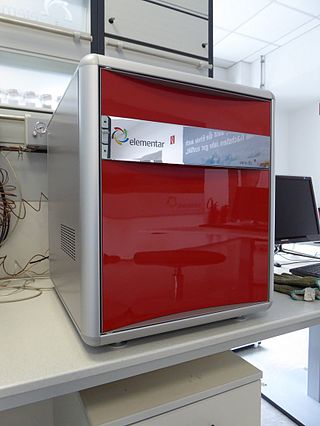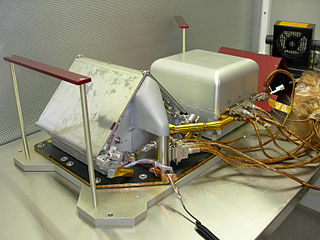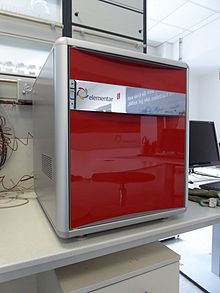
Isotope analysis is the identification of isotopic signature, abundance of certain stable isotopes of chemical elements within organic and inorganic compounds. Isotopic analysis can be used to understand the flow of energy through a food web, to reconstruct past environmental and climatic conditions, to investigate human and animal diets, for food authentification, and a variety of other physical, geological, palaeontological and chemical processes. Stable isotope ratios are measured using mass spectrometry, which separates the different isotopes of an element on the basis of their mass-to-charge ratio.

Mass spectrometry (MS) is an analytical technique that is used to measure the mass-to-charge ratio of ions. The results are presented as a mass spectrum, a plot of intensity as a function of the mass-to-charge ratio. Mass spectrometry is used in many different fields and is applied to pure samples as well as complex mixtures.

Secondary-ion mass spectrometry (SIMS) is a technique used to analyze the composition of solid surfaces and thin films by sputtering the surface of the specimen with a focused primary ion beam and collecting and analyzing ejected secondary ions. The mass/charge ratios of these secondary ions are measured with a mass spectrometer to determine the elemental, isotopic, or molecular composition of the surface to a depth of 1 to 2 nm. Due to the large variation in ionization probabilities among elements sputtered from different materials, comparison against well-calibrated standards is necessary to achieve accurate quantitative results. SIMS is the most sensitive surface analysis technique, with elemental detection limits ranging from parts per million to parts per billion.

Elemental analysis is a process where a sample of some material is analyzed for its elemental and sometimes isotopic composition. Elemental analysis can be qualitative, and it can be quantitative. Elemental analysis falls within the ambit of analytical chemistry, the instruments involved in deciphering the chemical nature of our world.
In chemistry, isotopologues are molecules that differ only in their isotopic composition. They have the same chemical formula and bonding arrangement of atoms, but at least one atom has a different number of neutrons than the parent.
Combustion analysis is a method used in both organic chemistry and analytical chemistry to determine the elemental composition of a pure organic compound by combusting the sample under conditions where the resulting combustion products can be quantitatively analyzed. Once the number of moles of each combustion product has been determined the empirical formula or a partial empirical formula of the original compound can be calculated.

Isotope-ratio mass spectrometry (IRMS) is a specialization of mass spectrometry, in which mass spectrometric methods are used to measure the relative abundance of isotopes in a given sample.

A carbon-to-nitrogen ratio is a ratio of the mass of carbon to the mass of nitrogen in organic residues. It can, amongst other things, be used in analysing sediments and soil including soil organic matter and soil amendments such as compost.

Prompt-gamma neutron activation analysis (PGAA) is a very widely applicable technique for determining the presence and amount of many elements simultaneously in samples ranging in size from micrograms to many grams. It is a non-destructive method, and the chemical form and shape of the sample are relatively unimportant. Typical measurements take from a few minutes to several hours per sample.

The mass recorded by a mass spectrometer can refer to different physical quantities depending on the characteristics of the instrument and the manner in which the mass spectrum is displayed.

The Thermal and Evolved Gas Analyzer (TEGA) is a scientific instrument aboard the Phoenix spacecraft, a Mars lander which landed and operated on the planet Mars in 2008. TEGA's design is based on experience gained from the failed Mars Polar Lander. Soil samples taken from the Martian surface by the robot arm are eventually delivered to the TEGA, where they are heated in an oven to about 1,000 °C. This heat causes the volatile compounds to be given off as gases which are sent to a mass spectrometer for analysis. This spectrometer is adjusted to measure particularly the isotope ratios for oxygen, carbon, nitrogen, and heavier gases. Detection values are as low as 10 parts per billion. The Phoenix TEGA has 8 ovens, which are enough for 8 samples.

Thermal ionization mass spectrometry (TIMS) is also known as surface ionization and is a highly sensitive isotope mass spectrometry characterization technique. The isotopic ratios of radionuclides are used to get an accurate measurement for the elemental analysis of a sample. Singly charged ions of the sample are formed by the thermal ionization effect. A chemically purified liquid sample is placed on a metal filament which is then heated to evaporate the solvent. The removal of an electron from the purified sample is consequently achieved by heating the filament enough to release an electron, which then ionizes the atoms of the sample. TIMS utilizes a magnetic sector mass analyzer to separate the ions based on their mass to charge ratio. The ions gain velocity by an electrical potential gradient and are focused into a beam by electrostatic lenses. The ion beam then passes through the magnetic field of the electromagnet where it is partitioned into separate ion beams based on the ion's mass/charge ratio. These mass-resolved beams are directed into a detector where it is converted into voltage. The voltage detected is then used to calculate the isotopic ratio.

Sample Analysis at Mars (SAM) is a suite of instruments on the Mars Science Laboratory Curiosity rover. The SAM instrument suite will analyze organics and gases from both atmospheric and solid samples. It was developed by the NASA Goddard Space Flight Center, the Laboratoire des Atmosphères Milieux Observations Spatiales (LATMOS) associated to the Laboratoire Inter-Universitaire des Systèmes Atmosphériques (LISA), and Honeybee Robotics, along with many additional external partners.
Isotopic analysis by nuclear magnetic resonance allows the user to quantify with great precision the differences of isotopic contents on each site of a molecule and thus to measure the specific natural isotope fractionation for each site of this molecule. The SNIF-NMR analytical method was developed to detect the (over) sugaring of wine and enrichment of grape musts, and is mainly used to check the authenticity of foodstuffs and to control the naturality of some aromatic molecules. The SNIF-NMR method has been adopted by the International Organisation of Vine and Wine (OIV) and the European Union as an official method for wine analysis. It is also an official method adopted by the Association Of Analytical Chemists (AOAC) for analysis of fruit juices, maple syrup, vanillin, and by the European Committee for Standardization (CEN) for vinegar.

NanoSIMS is an analytical instrument manufactured by CAMECA which operates on the principle of secondary ion mass spectrometry. The NanoSIMS is used to acquire nanoscale resolution measurements of the elemental and isotopic composition of a sample. The NanoSIMS is able to create nanoscale maps of elemental or isotopic distribution, parallel acquisition of up to seven masses, isotopic identification, high mass resolution, subparts-per-million sensitivity with spatial resolution down to 50 nm.
Hydrogen isotope biogeochemistry is the scientific study of biological, geological, and chemical processes in the environment using the distribution and relative abundance of hydrogen isotopes. There are two stable isotopes of hydrogen, protium 1H and deuterium 2H, which vary in relative abundance on the order of hundreds of permil. The ratio between these two species can be considered the hydrogen isotopic fingerprint of a substance. Understanding isotopic fingerprints and the sources of fractionation that lead to variation between them can be applied to address a diverse array of questions ranging from ecology and hydrology to geochemistry and paleoclimate reconstructions. Since specialized techniques are required to measure natural hydrogen isotope abundance ratios, the field of hydrogen isotope biogeochemistry provides uniquely specialized tools to more traditional fields like ecology and geochemistry.
Isotopic reference materials are compounds with well-defined isotopic compositions and are the ultimate sources of accuracy in mass spectrometric measurements of isotope ratios. Isotopic references are used because mass spectrometers are highly fractionating. As a result, the isotopic ratio that the instrument measures can be very different from that in the sample's measurement. Moreover, the degree of instrument fractionation changes during measurement, often on a timescale shorter than the measurement's duration, and can depend on the characteristics of the sample itself. By measuring a material of known isotopic composition, fractionation within the mass spectrometer can be removed during post-measurement data processing. Without isotope references, measurements by mass spectrometry would be much less accurate and could not be used in comparisons across different analytical facilities. Due to their critical role in measuring isotope ratios, and in part, due to historical legacy, isotopic reference materials define the scales on which isotope ratios are reported in the peer-reviewed scientific literature.

INFICON is headquartered in Bad Ragaz (Switzerland) and is engaged in the development, manufacture and supply of instruments, sensor technology and process control software for the semiconductor and vacuum-coating industries. They supply instruments for gas leak detection in refrigeration, air conditioning, the automotive industry and for the analysis and identification of toxic chemicals.

Hydroxyarchaeol is a core lipid unique to archaea, similar to archaeol, with a hydroxide functional group at the carbon-3 position of one of its ether side chains. It is found exclusively in certain taxa of methanogenic archaea, and is a common biomarker for methanogenesis and methane-oxidation. Isotopic analysis of hydroxyarchaeol can be informative about the environment and substrates for methanogenesis.











